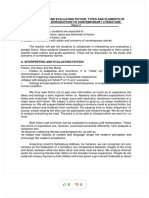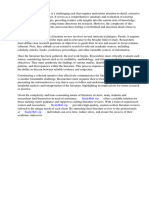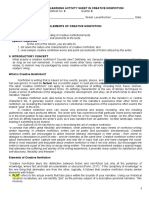CLIT 2095 final research paper topics
CLIT 2095 final research paper topics
Uploaded by
cindysylo1997Copyright:
Available Formats
CLIT 2095 final research paper topics
CLIT 2095 final research paper topics
Uploaded by
cindysylo1997Copyright
Available Formats
Share this document
Did you find this document useful?
Is this content inappropriate?
Copyright:
Available Formats
CLIT 2095 final research paper topics
CLIT 2095 final research paper topics
Uploaded by
cindysylo1997Copyright:
Available Formats
1.
Final Research/Response Paper – 35% 1500-2000 words
must treat at least two works from the course. The works you
choose for your research paper ideally should not be the same
as the work (s) you chose for your practical criticism (or there
should not be significant overlap). If you wrote on a graphic
novel for your practical criticism, you might choose from
different kinds of text for your research paper (ie.
autobiographies, novels, film, poetry etc.). Do not reproduce
your tutorial presentation. Any overlaps must be a leaping off
point to further explorations. This paper may incorporate
secondary criticism in the form of a traditional research paper
with a bibliography but it doesn’t have to. It may also take the
form of a personal response to the texts which expands upon
the practical criticism skills honed in the previous paper. This
is a course about paying close attention to how imaginative
works craft themselves as works of fiction and you are
encouraged to stay close to the texts in your analysis and to
include lots of direct citation. These will be assessed alongside
your practical criticisms so please do not be tempted to
duplicate material. Again, a reminder that if I suspect the
paper is the product of AI/ChatGPT, this will seriously affect
your grade. Your own voice and your own critical originality is
being assessed.
The paper is due by Midnight on Sunday 15th December to
the Turnitin tab on moodle.
You should come up with your own title on a topic of your
choice, or choose one from below. Possible essay titles may
include:
1. In two or more texts, discuss the portrayal of the family
including family relationships, family dynamics, questions
of empowerment and oppression, inter-and intra-
generational struggle. How do the authors portray
intimacy and/or hostility? what techniques do they use to
create their effects?
2. In many of the works from this course, there has been a
focus on “the small things”. Discuss the significance of
the small things in two or more texts. How might this
preoccupation with the small relate to the form, genre or
medium of your chosen works.
3. Autobiography is the genre of writing the self. Discuss the
portrayal of the self in two or more works. You might
comment on its construction or reconstruction through
memory, on the passage of time, on whether it is a
playful, authentic, audacious, serious, atoning self and
how it may or may not reflect the “true” identity of the
author.
4. The narrator is the key to any narrative, and particularly
to detective fiction and crime thrillers. Discuss the role of
the narrator and its relationship to truth and
representation in at least two works. You might comment
on reliable versus unreliable narrators, intradiegetic
narrators versus extradiegetic narrators and how this
impacts on the reader’s trust in what they are being told /
shown.
5. Cultural sensitivity is a key to empathic understanding.
Discuss the role of empathy and the way it is portrayed
textually and/or graphically in two or more works.
6. Discuss the way sex and gender impacts our reading of a
narrative. Is there such a thing as a feminine or
masculine way of writing? What are some of the
techniques or gestures in a narrative that are culturally
encoded masculine or feminine? Discuss with reference to
at least two works.
7. Discuss the relationship between text and image in two or
more works. What do we gain from a visual
representation as opposed to a textual one? How are
photographs different from sketches? What about
staging, lighting, and other forms of arranging? Is an
image more “the truth” than text? How do we understand
the subjectivity / objectivity divide in these kinds of
narratives?
8. Some writers / film makers / graphic artists are
consciously upending the genre in which they choose to
work. Discuss the way two authors innovate within their
chosen genres. What are some of the strategies and
techniques they use to create something different and
how effective are they?
9. Discuss the portrayal of childhood or a childlike
perspective in two or more works. What do we gain from
this artistic choice and what does it teach us about how
children see the world?
10. Psychologically, we tend to read for the plot, for the
ending, to figure out what happened and why. Compare
and contrast two works where reading for the ending is
satisfied and/or frustrated. What is the effect of being told
what happens right at the beginning of a narrative? Why
do we read on? What is gained by being thwarted or
frustrated in our ability to know “what really happened”?
11. Discuss the representation of the natural world in
two texts. How do images of nature interact with the
human story also present in the work?
You might also like
- Summit 2 (3rd) Teachers BookDocument20 pagesSummit 2 (3rd) Teachers BookDébora Jamileth Castro Zavaleta40% (5)
- Book ReviewDocument7 pagesBook ReviewAkshayMusaleNo ratings yet
- Seminar 6 The Verb 1. Theoretical CommentDocument5 pagesSeminar 6 The Verb 1. Theoretical Commentpolya100% (1)
- Hakim Sanai PoemsDocument24 pagesHakim Sanai PoemsPunnakayam67% (3)
- Paper 2 PromptsDocument3 pagesPaper 2 PromptsjiseokyangpeterNo ratings yet
- Literary AnalysisDocument2 pagesLiterary AnalysisYasmi DenawakeNo ratings yet
- Every Paper 2 Question So FarDocument3 pagesEvery Paper 2 Question So FarMuhammad Eman Rehan MalikNo ratings yet
- English 4C - Independent Study Outline: These Dates Are Subject To ChangeDocument6 pagesEnglish 4C - Independent Study Outline: These Dates Are Subject To Changeapi-476730596No ratings yet
- 0 Pwsfac1001182023143346Document6 pages0 Pwsfac1001182023143346MyraNo ratings yet
- MODULE IN CREATIVE NONFICTION Week 3 and Week 4Document5 pagesMODULE IN CREATIVE NONFICTION Week 3 and Week 4Jaja Cabatic100% (3)
- p2 QuestionsDocument8 pagesp2 QuestionsVibha RaviNo ratings yet
- English 10Document3 pagesEnglish 10Samantha SungaNo ratings yet
- Things Fall Apart : Discussion PromptsDocument5 pagesThings Fall Apart : Discussion Promptsapi-244383152No ratings yet
- SENIOR-HS Creative-Nonfiction Q1 LP9Document16 pagesSENIOR-HS Creative-Nonfiction Q1 LP9joan DoblonNo ratings yet
- ELE-208-learning-guide-Unit-4Document5 pagesELE-208-learning-guide-Unit-4Krisha Marie MuycoNo ratings yet
- Interpreting and Evaluating FictionDocument43 pagesInterpreting and Evaluating FictionGeneva TabiosNo ratings yet
- Literature.: Literary Analysis Means Closely Studying A Text, Interpreting Its Meanings, and Exploring Why TheDocument4 pagesLiterature.: Literary Analysis Means Closely Studying A Text, Interpreting Its Meanings, and Exploring Why Theglicer gacayanNo ratings yet
- ELE 208 Learning Guide Unit 4Document5 pagesELE 208 Learning Guide Unit 4Chaera MinbomNo ratings yet
- Analyzing StoriesDocument5 pagesAnalyzing StoriesAnwar Saheb100% (1)
- Uas Prose AnalysisDocument8 pagesUas Prose Analysisbuattranslate20021904No ratings yet
- English ReviewerDocument4 pagesEnglish ReviewerMelanie SaleNo ratings yet
- Writing A Formalist Literary AnalysisDocument5 pagesWriting A Formalist Literary AnalysisRey Cabrido RoseteNo ratings yet
- Analyzing StoriesDocument3 pagesAnalyzing StoriesrashidoslykunNo ratings yet
- Short Story Critique&TermsDocument5 pagesShort Story Critique&TermsEnnairisNo ratings yet
- English Paper 2 QuestionsDocument1 pageEnglish Paper 2 QuestionsКатерина ДьомкінаNo ratings yet
- EAAP Critical ApproachesDocument35 pagesEAAP Critical ApproachesJo AlabinNo ratings yet
- Formalist Analysis of A NovelDocument5 pagesFormalist Analysis of A NovelIbrahim ŞahinNo ratings yet
- Creative Writing: By: Kesia Mae Leonora AB PsychologyDocument7 pagesCreative Writing: By: Kesia Mae Leonora AB PsychologyKesia Mae LeonoraNo ratings yet
- Paper 2 QuestionbankDocument2 pagesPaper 2 QuestionbankJia MisraNo ratings yet
- Four QuartetsDocument5 pagesFour Quartetsjolina vittoNo ratings yet
- Write Your Positive or Negative Thoughts About The Picture.Document6 pagesWrite Your Positive or Negative Thoughts About The Picture.YVONE MAE MAYORNo ratings yet
- Lit Analysis OverviewDocument6 pagesLit Analysis Overviewapi-262573516No ratings yet
- Interpreter of Maladies BookletDocument35 pagesInterpreter of Maladies BookletCybeleNo ratings yet
- Week 5-6Document17 pagesWeek 5-6Christine BayaniNo ratings yet
- CNF Las 3Document9 pagesCNF Las 3Marianne D. PeritNo ratings yet
- Interpretingandevaluatingfiction CompressDocument11 pagesInterpretingandevaluatingfiction CompressErikha Joy DianonNo ratings yet
- EAPP Module 1Document8 pagesEAPP Module 1domingomilagros0No ratings yet
- Techniques of Literature ReviewDocument6 pagesTechniques of Literature Reviewafmaadalrefplh100% (1)
- LESSON PLAN of LiteratureDocument32 pagesLESSON PLAN of LiteratureAnouMalieNo ratings yet
- 7 Critical Reading StrategiesDocument6 pages7 Critical Reading StrategiesCherryGolez50% (2)
- Group 4Document25 pagesGroup 4yearnaffectionNo ratings yet
- Ahe 111 PPT 3 2o23Document32 pagesAhe 111 PPT 3 2o23Nikki OlivaNo ratings yet
- Composing A Scholarly Investigation PaperDocument4 pagesComposing A Scholarly Investigation Paperlevesquenoelle785No ratings yet
- Compose An Independent CritiqueDocument3 pagesCompose An Independent CritiqueChristian Bautista CoraceroNo ratings yet
- Close Reading: Basic Technique: Introduction To Poetry: Poetic Scansion Form and PerformanceDocument8 pagesClose Reading: Basic Technique: Introduction To Poetry: Poetic Scansion Form and Performancetonia dela cruzNo ratings yet
- Module 3Document20 pagesModule 3Honey Joy JuanNo ratings yet
- Literature Review MetaphorDocument4 pagesLiterature Review Metaphoraflslcqrg100% (1)
- Worksheet 3Document5 pagesWorksheet 3Laila Olfindo100% (1)
- ENG 107 (Module 5) PDFDocument30 pagesENG 107 (Module 5) PDFDeniel DenamarcaNo ratings yet
- Cause and Effect Essay ModelDocument16 pagesCause and Effect Essay ModelMohan TumbahangNo ratings yet
- Types of EssayDocument3 pagesTypes of EssayNerinel CoronadoNo ratings yet
- Kai Mikkonen, Every Knowledge in Understanding Fictional Characters and Their WorldsDocument8 pagesKai Mikkonen, Every Knowledge in Understanding Fictional Characters and Their Worldsdfg gdfgdfNo ratings yet
- Literary Criticism: Questions For A Variety of ApproachesDocument2 pagesLiterary Criticism: Questions For A Variety of ApproachesAly Swift100% (1)
- Literary Theory DefintionsDocument5 pagesLiterary Theory DefintionsJace AbeNo ratings yet
- EAPP Qtr-3 Week-3Document5 pagesEAPP Qtr-3 Week-3Angela Ellijah MelendezNo ratings yet
- Bjorem Unit Plan Final V1Document8 pagesBjorem Unit Plan Final V1k_b_bjoremNo ratings yet
- #2 ReflectionDocument4 pages#2 Reflection363304379No ratings yet
- Literary Criticism Generic QuestionsDocument3 pagesLiterary Criticism Generic QuestionsJohn Francis CruzNo ratings yet
- Essay 2 Fall 2015Document3 pagesEssay 2 Fall 2015api-301971997No ratings yet
- What Is Close ReadingDocument11 pagesWhat Is Close Readingayhermas32No ratings yet
- Identifying Themes PDFDocument2 pagesIdentifying Themes PDFArianne Lee100% (1)
- The Construction of Character: A Wait, Wait, Don't Query (Yet!) BookFrom EverandThe Construction of Character: A Wait, Wait, Don't Query (Yet!) BookNo ratings yet
- Ed Pronunciation British English Student Ver2Document2 pagesEd Pronunciation British English Student Ver2charrak.amazNo ratings yet
- LearnEnglish Listening B1 - An Introduction To A LectureDocument4 pagesLearnEnglish Listening B1 - An Introduction To A LectureLuis SGNo ratings yet
- Final-Nd2-Project AllocationDocument46 pagesFinal-Nd2-Project AllocationTravisNo ratings yet
- TCode & Table DataDocument10 pagesTCode & Table DataguniporgaNo ratings yet
- English8quarter1slm2-Template APA-MLA Pages 5-7Document3 pagesEnglish8quarter1slm2-Template APA-MLA Pages 5-7jelly marie floresNo ratings yet
- Data Handling - Print - QuizizzDocument3 pagesData Handling - Print - QuizizzHarshit PathakNo ratings yet
- Datastage Transformer FunctionsDocument21 pagesDatastage Transformer FunctionsbabjeereddyNo ratings yet
- Environment and Needs Analysis: Week 2Document38 pagesEnvironment and Needs Analysis: Week 2BeyzaNo ratings yet
- EDL 231 Reflection PaperDocument2 pagesEDL 231 Reflection PaperDanna Mae Terse YuzonNo ratings yet
- Apache Spark FeaturesDocument2 pagesApache Spark FeaturesnitinluckyNo ratings yet
- Drop BoxDocument10 pagesDrop BoxCarlos VasquezNo ratings yet
- Samsung LE26R86BD LCD TelevisionDocument451 pagesSamsung LE26R86BD LCD TelevisionarpcproNo ratings yet
- Past Simple and Past Continuous - Extra Practice-2Document1 pagePast Simple and Past Continuous - Extra Practice-2lokuraantomillenniumNo ratings yet
- Lesson 1-Grade 9Document20 pagesLesson 1-Grade 9Mike Cortez AutorNo ratings yet
- TVL Comprog 12 q3 m1Document13 pagesTVL Comprog 12 q3 m1jhndmtvdNo ratings yet
- 2569968Document6 pages2569968Sahil PawarNo ratings yet
- 单片机驱动LIS3DHDocument62 pages单片机驱动LIS3DHgonglun liNo ratings yet
- LP in AstronomyDocument7 pagesLP in Astronomyarmand rodriguezNo ratings yet
- Blazing Text Navigating The Dimensional LabyrinthDocument91 pagesBlazing Text Navigating The Dimensional LabyrinthsurendersaraNo ratings yet
- Syllabus LUMS-EOBI Recruitment Test For Deputy Director IT Cadre (BPS-18)Document2 pagesSyllabus LUMS-EOBI Recruitment Test For Deputy Director IT Cadre (BPS-18)aofficerrasulNo ratings yet
- Fixed Point Theory and Related TopicsDocument238 pagesFixed Point Theory and Related TopicsHans Brix HansenNo ratings yet
- Materi Ajar Invitation - Nur Atmi F RevisiDocument30 pagesMateri Ajar Invitation - Nur Atmi F RevisiZyahAtMieNo ratings yet
- Past SimpleDocument7 pagesPast SimpleBerende MonalisaNo ratings yet
- SUGGESTED Listening Games, Exercises and Activities For AdultsDocument47 pagesSUGGESTED Listening Games, Exercises and Activities For Adultsasialight3333No ratings yet
- Chapter VIDocument35 pagesChapter VIJulius MacaballugNo ratings yet
- English IIDocument4 pagesEnglish IIMarcelo LuceroNo ratings yet
- Tech Spec EricssonMINSA 5-1 Version 1-0Document2 pagesTech Spec EricssonMINSA 5-1 Version 1-0Rasool WaniNo ratings yet

























































































